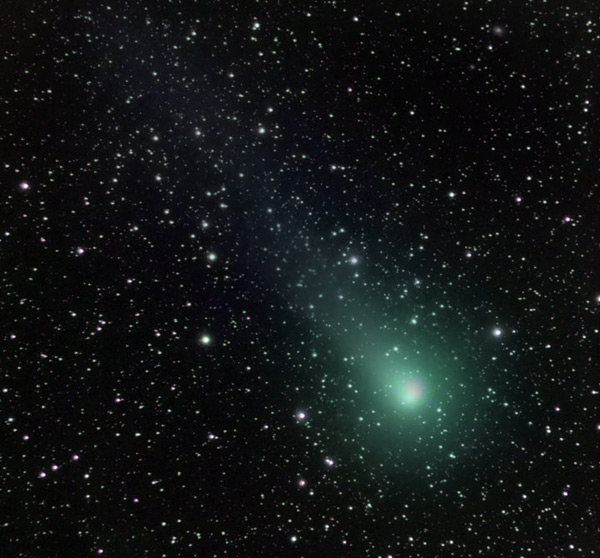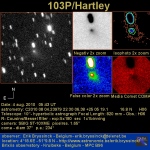Posted by Warren Wong on Monday, January 23, 2012,
In :
Star birth
Stars begin life as clouds of cold gas that transform into blazing hot fireballs.
Star dust, star dust, burning bright
Amid the glare of ancient light
Eternity stares back from the past
Reborn we'll be one day as dust
Stellar astrophysics
January 14, 2012 – Walk out to a dark viewing spot anywhere on the Earth and look up at the night sky. Your eyes will take in ancient light from stars in the Milky Way that covers the whole sky above you. Deep within the stellar nurseries of the Mil... Continue reading ...
A Winter Comet Treat
To entertain you through the January nights
 Photo courtesy of NASA Photo courtesy of NASA
Viewers living in the Northern Hemisphere looking for a winter astronomy treat to keep them entertained through the cold January nights should be able to get a look at Comet C/2009 P1 (Garradd). The Northern Hemisphere night sky hasn't played host to a bright comet since Comet C/1995 O1 (Hale-Bopp) in 1997, although a few were bright enough to view with binoculars. This month viewers have a very good chance of viewing Garrad... Continue reading ...
Dawn Falling Toward Vesta
Dawn is falling toward Vesta today as NASA's spacecraft is currently circling one of the largest asteroids in the solar system and preparing to take a closer look at an asteroid first viewed by German astronomer Heinrich Wilhelm Olbers on March 29, 1807. The picture above is one of the latest images taken by Dawn of three craters on the surface of Vesta called “Snowman”that are located in Vesta's northern hemisphere. The associated picture below is of craters visible in the southern e... Continue reading ...
The Human Journey to the Beginning of Space and Time Turns the Page

The human journey to the beginning of space and time will soon turn the page in space history as the end of an era of human space exploration that will be remembered as a time when America and the world first dared to venture beyond the confines of Earth's atmosphere and into the darkness of the unknown comes to an end. The fourth space orbiter built to help take American astronauts into low orbit, Space shuttle Atlantis is scheduled to lift-off of Kennedy Space Centre's Launch Pad 39A f... Continue reading ...
NASA's Curiosity is Almost Ready to Journey to Mars
Posted by Warren Wong on Monday, June 6, 2011,
In :
Mars

The human journey to the beginning of space and time will get a detailed view of Mars using the Mast Camera on NASA’s Mars rover Curiosity, once Curiosity lands on the surface of Mars, sometime around August 2012, according to the latest estimates by NASA. Space travel is by necessity extremely well planned and every detail must be worked out to a set time table if the Curiosity is to accomplish its mission. All aspects of the mission parameters must be analysed and reanalysed to ensure eve...
Continue reading ...
MESSENGER Sends Back First Messages
NASA's MESSENGER spacecraft has finally started sending back the first images of the solar systems inner most planet ever taken by a human made invention on March 29. The first views are of the south and north polar regions of Mercury were released by NASA on March 29 and March 30, and they paint a new portrait of the surface of Mercury than the one astronomers had previously painted. The first images of the surface of Mercury show a crater strewn surface use to continual bombardment over mil... Continue reading ...
Take a Nightly Celestial Ride during September
The nights of September 2010 will feature essentially the same night sky as the one your ancestors used as a basis for many of the myths and stories that have been passed down to the modern world of today. September's star gazers can sit huddled around the fire each night of the month, as celestial delights about on a nightly basis, just as they did thousands of years in the past. The perfect time to board your time machine to the stars and take a journey through space and time or lay your ba... Continue reading ...
The Windswept Northern Polar Cap of Mars
Posted by Warren Wong on Friday, November 19, 2010,
In :
Mars
 - Mars north polar cap has a few interesting features for star gazers to see. NASA photo.
Scientists using the Shallow Radar (SHARAD) instrument on NASA's Mars Reconnaissance Orbiter to look beneath Mar's north polar ice cap and get an idea of the lay of the ground think they know how Chasma Boreale and the much discussed series of spiral troughs were formed. The formation of Chasma Boreale and enigmatic spiral troughs have been talked about for four decades by space scientists and am... Continue reading ...
Begin Planning Your Journey to Comet 103P/Hartley
Board your time machine to the stars near the end of October
 - Comet 103P/Hartley leaves a trail as it travels through the inner solar system
September is the time for you and the kids to begin planning a journey to a celestial body that will be at its closest point to Earth and Sol, sometime near the end of October. Comet 103P/Hartley has been in the news, of late, as NASA's Deep Impact spacecraft will fly by Comet 103P/Hartley, in the first part of November. Observers boarding their ... Continue reading ...
Journey to the Small Near-Earth Asteroid 25143 Itokawa
Posted by Warren Wong on Thursday, November 18, 2010,
In :
asteroids
What do you think a little asteroid dust could tell us about the universe?
 - Hayabusa has returned from its mission to asteroid 25143 Itokawa
The return capsule of Japan Aerospace Exploration Agency's asteroid-hunting Hayabusa spacecraft splashed down safely near Australia on June 13. This marks the return of a space traveller that was launched in 2003 in order to journey to the small near-Earth asteroid 25143 Itokawa to bring back a sample of the asteroid's surface. Hayabusa has been d... Continue reading ...
Cradle for a New Human Genesis
Posted by Warren Wong on Saturday, November 13, 2010,
The search for a new home for human life has started
 - Planets with water are the goal of astronomers. NASA photo.
The search for planets capable of acting as a cradle for a new human genesis has begun. Astronomers are searching the night sky above you for planets circling distant stars within what space scientists refer to as a stars life-zone or habitable-zone. This zone is an area at an orbital distance from the star in question that allows for the formation of the elements of life ... Continue reading ...
Mankind's Next Great Step into the Cosmos
The James Webb Space Telescope Takes Mankind to the Edge of Infinity
 - The James Webb Space Telescope Journeys to the Beginning of Space and Time
Mankind's journey to the beginning of the universe is about to voyage into unknown areas of the universe in search of answers to questions that were in the minds of the first star gazers. Why are we here? Are we alone in the universe or is life abundant? Plans to launch the James Webb Space Telescope into ...
Continue reading ...
October's Early Morning Sky Puts on a Show
Posted by Warren Wong on Thursday, November 11, 2010,
In :
meteorites
Comet Halley dust rains down upon Earth in the early mornings of October
 - Periodic trips through the inner solar system has left a little dust behind. NASA photo.
Modern star gazers can take in a show that has been entertaining star gazers for thousands of years. The Orionid meteor shower peaks on the night of October 21, the Moon will also be in full phase on this night, and this light will drown out the light of all but the most energetic of meteorites. The Orionid m...
Continue reading ...
The Planetary Zoo is Expanding Accommodations for New Arrivals
Posted by Warren Wong on Wednesday, November 10, 2010,
In :
exo-planets
 - What would life be like on a planet with such a weird orbit?
"Journey to the Beginning of Space and Time" to view the planetary zoo
 - Looking for a new place to live?
Space scientists looking at the rapidly expanding menagerie of planets being added to the planetary zoo keep coming back from their journey wide-eyed and smiling like a kid that just got the key to the candy store. The latest editions to the planetary zoo are orbiting celestial bodies in orbits totally out-of-whack...
Continue reading ...
Collisions in Space
 - Something might have hit THEMIS-B. NASA photos.
Considering the volume of bodies circling in the solar system one might think that collisions between bodies in the solar system is commonplace, but in fact collisions between bodies circling in the solar system are relatively uncommon. This is what makes a recent report by NASA of a possible collision of one of their spacecraft with a meteorite a highlight of sorts, or at least something relatively unusual. NASA reported a possible colli... Continue reading ...
An Infinite Number of Galaxies?
Posted by Warren Wong on Friday, November 5, 2010,
In :
galaxies
 - Just how many galaxies is an infinite number, anyway? NASA photos.
So many planets, so much diversity! Can life really be limited to Earth?
The galaxies you'll view during your journey to the beginning of the universe are like grains of sand on the beach, or snowflakes, with no two galaxies looking exactly the same to viewers. Astronomers have also viewed a number of different types of galaxies on the human journey to the beginning of the universe that they... Continue reading ...
The More We Look, the More We Wonder?
Posted by Warren Wong on Friday, November 5, 2010,
In :
exo-planets
 NASA photos NASA photos
Do we really know anything?
The more astronomers look around on the human journey to the beginning of the universe, the more they realise we really have only scratched the surface of the known universe, and we really know nothing. This is exciting, for sure, for astronomers viewing the universe, but it means space scientists are constantly reworking theories and ideas concerning the universe and the way things really work. Astronomers using NASA's Spitzer Space Telescope to vi...
Continue reading ...
Feeling Isolated? The Universe is Closer Than You Think
 Photos NASA: IBEX recently completed a six-month survey of the sky. Photos NASA: IBEX recently completed a six-month survey of the sky.
Mankind is preparing to journey to the outer solar system in the decades ahead and part of the preparation is using NASA's Interstellar Boundary Explorer, or IBEX, spacecraft to take a look at conditions on the edge of the solar system to get an idea of the environment humans and the spacecraft we send to the edge of the solar system will have to withstand to survive. NASA's Interstellar Boundary Explorer has just finished pro... Continue reading ...
The Planets Dance Across September's Night Sky
 NASA photo NASA photo
September is one of the year's most entertaining and awe-inspiring months to lay on your back on a dark hill and view the delights of the celestial dance in the sky above you as your ancestors once did on a nightly basis. Four of Sol's dance partners will be in the spotlight in September, 2010, taking part in a nightly dance that includes their less observable brothers and sisters, while Mercury will once again dance privately in the eastern sky each morning during September.
Mighty ...
Continue reading ...
|
Author
Warren Wong
Prince George, British Columbia. Canada
|